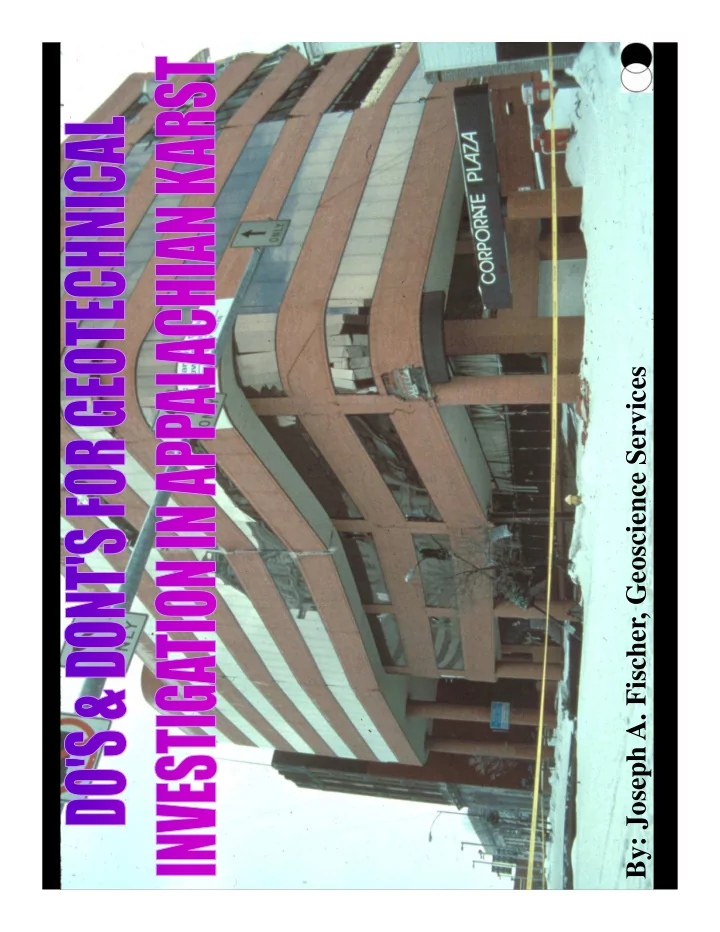

By: Joseph A. Fischer, Geoscience Services
PRINCIPLE TYPES OF “KARST” • Recent, sandy and coralline carbonates of Florida and the Caribbean. • Hard, but flat-lying carbonates of the central U.S. • Hard, but folded and faulted (and some metamorphosed) carbonates of the eastern & western U.S.
YOU SHOULDN’T BUILD… UNLESS YOU KNOW WHAT’S UNDERNEATH
OOPS!!
MORE COMMON WEATHERED ROCK SOIL ARCH SOIL VOID Appalachian Karst Failure Modes In SOIL-FILLED SEAMS SOIL FRACTURES LESS COMMON
GEOTECHNICAL CONCERNS • Highly variable bedrock surface with soft soils and/or voids right on top of the rock can lead to differential settlement problems. • Voids within the rock and overburden need to be considered in design to avoid foundation support failures. • Highly variable properties of “bent” rock and surficial soils can cause support concerns. • Vertical differences in the bedrock surface of 50 feet or more have been experienced over a horizontal distance of 10 feet.
GEOHYDROLOGICAL CONCERNS • Surface water follows solution-enhanced joints, fractures, faults and shear zones. • Fracture orientation in relation to in-situ stress orientation can allow deeper fracture penetration, thus increasing the likelihood of deeper solutioned channels. • Ground water movement in karst usually does not behave like isotropic, anisotropic or slab-fissured/fractured rock aquifers. Can behave like a pipe (conduit) or channel flow.
GEOHYDROLOGICAL CONCERNS (continued) • Contaminants can travel great distances undiluted and unfiltered creating a great concern for water supply wells. • Appropriate well head and aquifer protection needed. • Dye trace studies, where they work, are often necessary to characterize flow within solutioned carbonate aquifers. • Currently, some sinkholes are used to control surface water flows.
Whether doing… 1. Pre-site selections studies, 2. Site evaluation, or 3. Failure evaluation, The concepts are generally similar.
Solution Concepts • Solutions require knowledge/experience in engineering geology, rock mechanics, soil mechanics, hydrogeology/geohydrology, and geophysics (i.e. a multi-disciplined team approach to investigation, evaluation, design and remediation). • Nature of the project. • Knowledge/understanding of karst by the owner’s design team. • Funding.
Investigative Tools • Available information for the locale of interest. • Experience with the soil and rock types of the locale of interest. • Direct Investigation (drilling, test pits, probes). • Indirect (geophysics). • Dye Tracing.
Available Information
Glacial Terrain or Karst Terrane? Kettle Holes or Sinkholes?
“Bent” Karst • Aerial Imagery • EM Profiling • On-Site Mapping • Gravity • Local Quarries and • Test Pits Rock Cuts • Test Borings • Resistivity • VLF? • Seismic Reflection/ • GPR? Refraction?
TOOLS AND TECHIQUES • Use a split, double-tube core barrel for rock sampling. Allows determination of fracture orientation, angle and often recovers void filling. • Monitor water/air loss quantities and depths. • Monitor grout-take quantities and depths.
Effectiveness And Utility Of Geophysics In Karst • Variable • Young karst – generally good • Flat karst – generally good • Bent karst – generally poor, but can work
? Fold
Do’s Don’ts • Don’t expect to accomplish an • Do a karst site study in economical & comprehensive phases. karst site study in a single step. • Don’t assume that the • Do use the available available information information with a site accurately portrays a reconnaissance. particular site. • Don’t assume your model is • Do develop a preliminary inflexible. geologic model. • Don’t ignore the value of • Do refine the model as site direct testing. specific data is developed. • Don’t interpret the • Do consider geophysics as a geophysical data without hard tool. data and experience.
Do’s Don’ts • Don’t assume geophysics • Do consider resolution or direct testing has and technique when shown you everything. using geophysics. • Don’t ignore overburden • Do consider the value properties and geologic of remedial grouting orientation when as an interpretive tool choosing a grouting for the geologic model technique. developed. • Don’t forget to inspect • Do consider other open excavations during remedial measures construction. such as dynamic destruction.
BILLBOARD
Recommend
More recommend